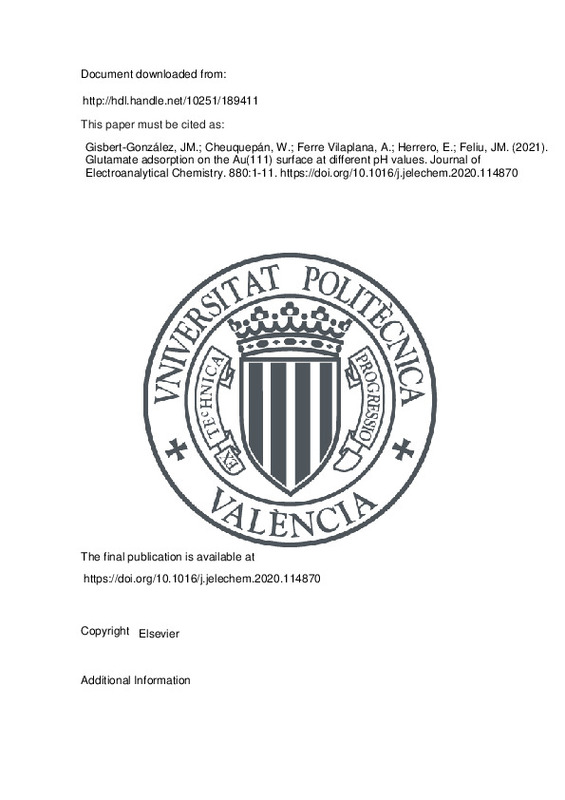JavaScript is disabled for your browser. Some features of this site may not work without it.
Buscar en RiuNet
Listar
Mi cuenta
Estadísticas
Ayuda RiuNet
Admin. UPV
Glutamate adsorption on the Au(111) surface at different pH values
Mostrar el registro sencillo del ítem
Ficheros en el ítem
| dc.contributor.author | Gisbert-González, José M.
|
es_ES |
| dc.contributor.author | Cheuquepán, William
|
es_ES |
| dc.contributor.author | Ferre Vilaplana, Adolfo
|
es_ES |
| dc.contributor.author | Herrero, Enrique
|
es_ES |
| dc.contributor.author | Feliu, Juan M.
|
es_ES |
| dc.date.accessioned | 2022-11-07T19:02:15Z | |
| dc.date.available | 2022-11-07T19:02:15Z | |
| dc.date.issued | 2021-01-01 | es_ES |
| dc.identifier.issn | 1572-6657 | es_ES |
| dc.identifier.uri | http://hdl.handle.net/10251/189411 | |
| dc.description.abstract | [EN] Adsorbed amino acids can modulate the behavior of metal nanoparticles in advanced applications. Using a combination of electrochemical experiments, FTIR spectroscopy, and DFT calculations, glutamate species interacting with the Au(111) surface in solution are here investigated. Electrochemical results indicate that the adsorption behavior depends on the solution pH (which controls the glutamate ionization) and on the charge of the surface. Glutamate adsorption starts at potentials slightly negative to the potential of zero charge. The thermodynamic analysis of these results indicates that two electrons are exchanged per molecule, implying that both carboxylic groups become deprotonated upon adsorption. The FTIR spectra reveal that carboxylate groups are bonded to the surface in the bidentate configuration (with both oxygen atoms attached to the surface). Plausible adsorbed configurations, consistent with the whole of these insights, were found using DFT. -Additionally, it was observed that glutamate oxidation only takes place when the surface is oxidized, which suggests that this oxidation process involves the transfer of an oxygen group to the molecule, though, according to the FTIR spectra, the main chain remains intact. | es_ES |
| dc.description.sponsorship | Financial support from Ministerio de Ciencia e Innovacion (Project PID2019-105653GB-100) and Generalitat Valenciana (Project PROMETEO/2020/063) is acknowledged. | es_ES |
| dc.language | Inglés | es_ES |
| dc.publisher | Elsevier | es_ES |
| dc.relation.ispartof | Journal of Electroanalytical Chemistry | es_ES |
| dc.rights | Reconocimiento - No comercial - Sin obra derivada (by-nc-nd) | es_ES |
| dc.title | Glutamate adsorption on the Au(111) surface at different pH values | es_ES |
| dc.type | Artículo | es_ES |
| dc.identifier.doi | 10.1016/j.jelechem.2020.114870 | es_ES |
| dc.relation.projectID | info:eu-repo/grantAgreement/AEI/Plan Estatal de Investigación Científica y Técnica y de Innovación 2017-2020/PID2019-105653GB-I00/ES/ESTUDIOS MECANISTICOS AVANZADOS DE REACCIONES ELECTROQUIMICAS RELACIONADAS CON LA ENERGIA/ | es_ES |
| dc.relation.projectID | info:eu-repo/grantAgreement/GVA//PROMETEO%2F2020%2F063/ | es_ES |
| dc.rights.accessRights | Abierto | es_ES |
| dc.description.bibliographicCitation | Gisbert-González, JM.; Cheuquepán, W.; Ferre Vilaplana, A.; Herrero, E.; Feliu, JM. (2021). Glutamate adsorption on the Au(111) surface at different pH values. Journal of Electroanalytical Chemistry. 880:1-11. https://doi.org/10.1016/j.jelechem.2020.114870 | es_ES |
| dc.description.accrualMethod | S | es_ES |
| dc.relation.publisherversion | https://doi.org/10.1016/j.jelechem.2020.114870 | es_ES |
| dc.description.upvformatpinicio | 1 | es_ES |
| dc.description.upvformatpfin | 11 | es_ES |
| dc.type.version | info:eu-repo/semantics/publishedVersion | es_ES |
| dc.description.volume | 880 | es_ES |
| dc.relation.pasarela | S\427485 | es_ES |
| dc.contributor.funder | Generalitat Valenciana | es_ES |
| dc.contributor.funder | Agencia Estatal de Investigación | es_ES |
| dc.subject.ods | 03.- Garantizar una vida saludable y promover el bienestar para todos y todas en todas las edades | es_ES |







![[Cerrado]](/themes/UPV/images/candado.png)

